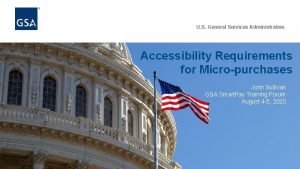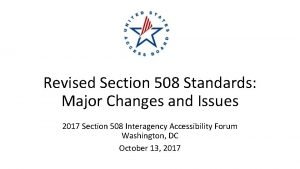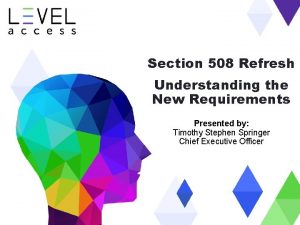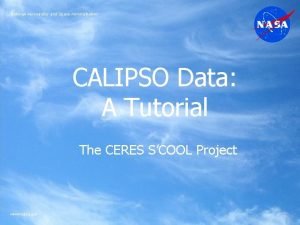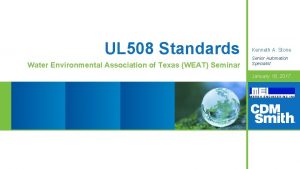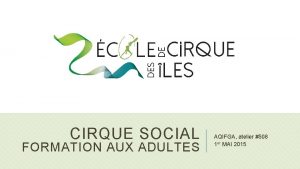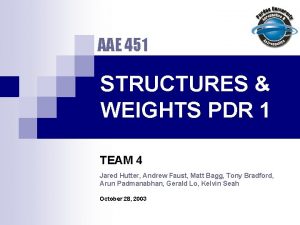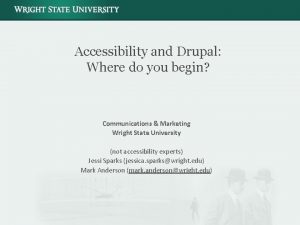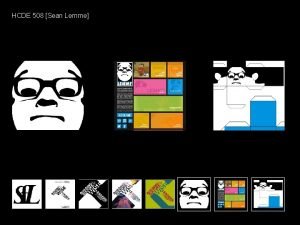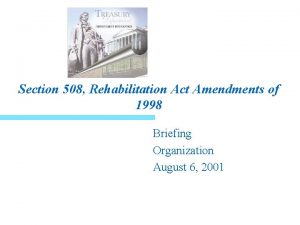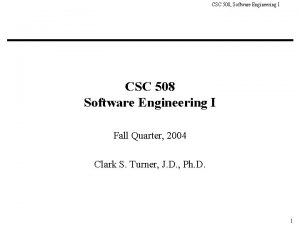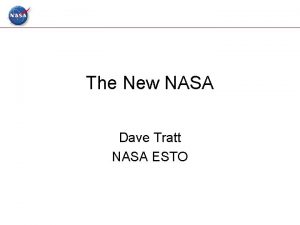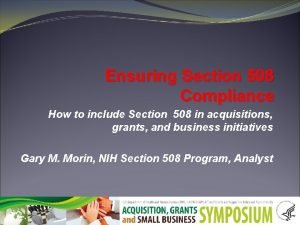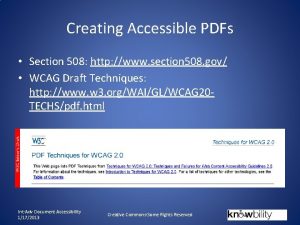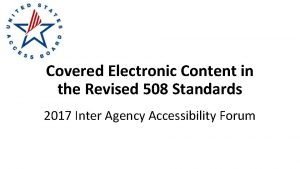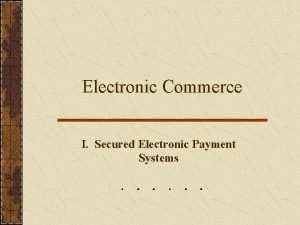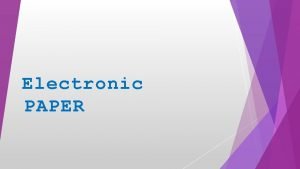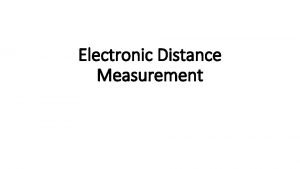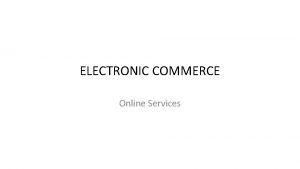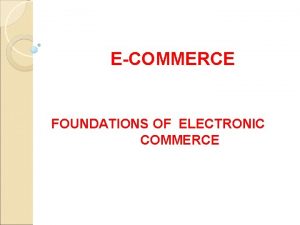Section 508 and NASA Session 2 Electronic ContentDocuments














- Slides: 14

Section 508 and NASA Session 2: Electronic Content/Documents Presentation to Ames Research Center November 2011 Antonio Haile. Selassie

What Is Section 508? In 1998, Congress amended the Rehabilitation Act of 1973 to include Section 508, which provides people with disabilities opportunities to gain meaningful employment with the Federal government and to reflect the focus on technology. NASA Section 508 Policy NPR 2800. 2 2

Why Electronic Documents? The Access Board’s Technical Standard § 1194. 22 (Web-based intranet and internet information and applications) applies to Electronic Documents at the point that they are distributed over an “intranet” or the “internet”, to the public or Federal Employees, via NASA external or internal Web sites (FTP, HTTP, etc. ), email, file sharing (Share. Point or other document management system), or other electronic means. Electronic documents created and stored for individual use are not required to comply with Section 508 accessibility standards. 3

Common Examples Email Spreadsheets Word Processing Documents Portable Document Format (pdf): Commercial Office Document Suites: Microsoft Office, Open Office, Google. Docs, Star. Office, Lotus, etc. 4

Policy: Electronic Documents 2. 3. 1. 1 Official communication shall be made accessible to persons with disabilities. Official communication refers specifically to communication by a Federal agency to employees that contains information necessary for those employees to perform their job functions, or communication by a Federal agency to members of the general public that contains information necessary for the conduct of official business with the agency. Examples of such electronic content may include e-mail messages, Word documents, . pdf documents, and other types and formats. . . 5

Policy: Electronic Documents 2. 3. 1. 2 Broadcast e-mails and e-mails generated by Web applications will comply with the applicable Section 508 technical standards. Broadcast e-mails, as defined in this standard, are those e-mails sent: a. By a NASA civil servant, contractor, or appointee to any group or list comprised of persons, some of whom are not personally known to the sender, or b. b. As final documents intended for distribution to other Federal officials or to members of the public seeking information and services. 2. 3. 1. 3 Electronic documents created and stored on individual workstations are not required to comply with Section 508 accessibility standards. 6

Best Practices Place content in a logical reading order. – Avoid complex layouts, sidebars and other ornamentation, when possible, as they can make it difficult to maintain a logical reading order. Avoid embedded multimedia. – If used, all embedded multimedia would need synchronized captions and audio descriptions. Use style elements to format your document – Use style elements to create headers and place the headers in a logical and consistent or incremental order. For example, a document should not jump from a "Heading 1" style to a "Heading 4" style. – Lists: Use native application’s styling functions for Bulleting/Numbering preformatted lists as a tool to make your lists accessible. 7

Best Practices Ensure all images and other non-text elements (graphs, illustrations, images of data tables, clip-art, audio, video, etc. ) have alternate text. – Any image/picture of a chart, table, graph, text, or other non-text element must be fully described textually. Charts and tables must be described in greater detail, which means including numbers and what those numbers represent. – For basic images, do not overcomplicate the description and only provide the information necessary to explain the main purpose of the image in the context of the document. – Embedding audio/video should be avoided, but, if needed, textual equivalents (i. e. transcripts, text descriptions) or links to textual equivalents should be provided. – Note: Images and other non-text elements that are strictly decorative are not required to have alternate text. 8

Best Practices Avoid using tables for layout – If you must use a table for layout, remember that screen readers and Braille displays read tables row-by-row, left-to-right across the columns. For data tables, make sure all column and row headers are clearly identifiable. – Use differential styling to indentify headers (i. e. create a unique style called “Table Header”) or at the very least use bold or a larger font. This helps readers to distinguish headers from the data in the table. – Note: There is a technical standard requiring markup to be used to associate data cells with header cells for tables with complex headers. This is not possible using some document development tools so keep your data tables to a single row/column of headers, when possible. –. 9

Best Practices Do not use TAB, Spacebar, or Enter keys to format tables, columns, lists etc. – use built-in features (i. e. margins, spacing, “Insert Table”) to encode the semantic structures for content like headings, paragraphs, lists, sections, headers/footers, tables (never use the “Draw Table” feature), columns, forms etc. Use standard fonts. – Do not use fonts that do not map to Unicode. Avoid placing content in drawing-canvases or textboxes – these are “floating objects” and can flow to the bottom of a page's readingorder. All hyperlinks should contain the correct hyperlink and display the fully qualified URL – i. e. , http: //www. nasa. gov and not www. nasa. gov or click here 10

Best Practices Ensure that color is NOT the sole means of conveying information. – Color and highlighting can be used for markup, but should not be the only way to provide information. – For example, you can use red text within a document to highlight specific information, but if you direct a reader to, “follow the instructions in red” this information may not be discernable to an individual with color blindness. In this case, it would be better to enclose the specified text using textual notations such as an asterisk or brackets and direct the user to, “follow the directions enclosed in brackets”. Use a high contrast between background colors and text colors. – Individuals with low vision or color blindness may not be able to read text that does not have a high degree of contrast between text and background. Use light text on dark backgrounds and dark text on light backgrounds 11

Demonstration Making a Word Document accessible. Converting an Accessible Word Document to PDF. Making PDF Accessible. 12

Resources www. section 508. nasa. gov – General and NASA-specific information and resources NASA virtual Section 508 help desk – section 508 help@nasa. gov – Available to NASA employees and contractors www. section 508. gov – GSA site: general information, training, lots of relevant links (law, standards, etc. ) www. access-board. gov/508. htm – Access Board developed standards. 13

Questions? 14
 Micro-purchases and section 508 requirements
Micro-purchases and section 508 requirements Revised 508 standards
Revised 508 standards 508 refresh
508 refresh Dhs selc guidebook
Dhs selc guidebook Ano ang kahulugan ng ngayon kakahigin ngayon tutukain
Ano ang kahulugan ng ngayon kakahigin ngayon tutukain Nasa www.nasa.gov
Nasa www.nasa.gov Electronic field production examples
Electronic field production examples Scrip exchange
Scrip exchange Ul 508 standard
Ul 508 standard Atelier 508
Atelier 508 Aae 508 purdue
Aae 508 purdue Drupal 508 compliance
Drupal 508 compliance Hcde 508
Hcde 508 Site:slidetodoc.com
Site:slidetodoc.com Section 2 describing energy (continued)
Section 2 describing energy (continued)
